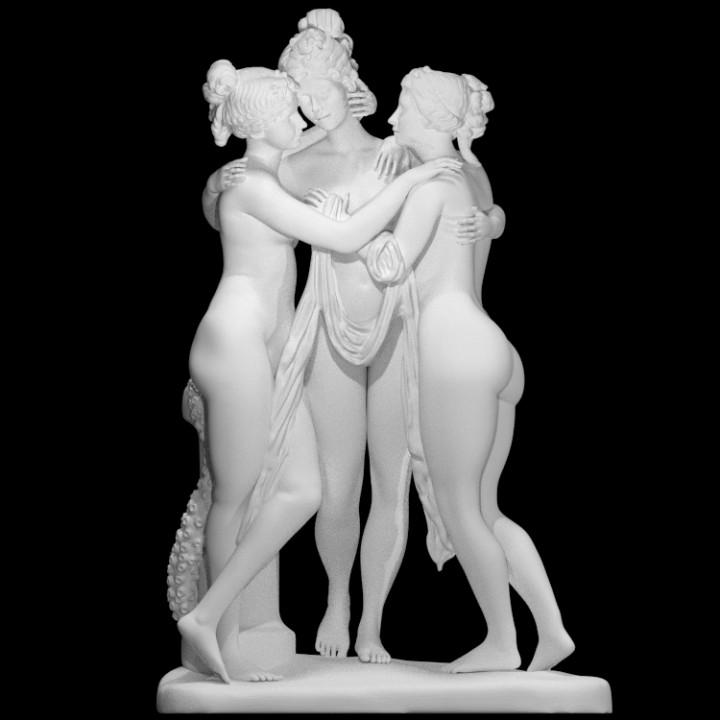
The Three Graces at the Hermitage Museum, Russia
myminifactory
Antonio Canova's masterpiece, The Three Graces, stands as a breathtaking Neoclassical sculpture, crafted in exquisite marble, showcasing the mythological three charites, daughters of Zeus - identified on some engravings as Euphrosyne, Aglaea, and Thalia. These captivating figures embody beauty, charm, and joy, presiding over banquets and gatherings to enthrall the gods' guests. As such, they have long been a source of inspiration for historical artists like Sandro Botticelli and Bertel Thorvaldsen. The three nude women, symbols of beauty, arts, and fertility, stand together in a harmonious line, signifying their alliance. The marble piece, created in the 11th century AD, was discovered on mount Caelius in Rome. Based on an earlier artwork from the hellentistic period (330-30 BC), it can be found at the Metropolitan Museum of Art in New York. Other versions of this sculpture can be explored here and here. This piece is a reworking of the original by Jean-Jacques Pradier (1790-1852), crafted in marble and presented to the salon in 1831, loosely based on Botticelli's painting of The Three Graces in 'La Primavera' from 1550. This magnificent object is part of "Scan The World", a non-profit initiative introduced by MyMiniFactory, aiming to create a digital archive of fully 3D printable sculptures, artworks, and landmarks from across the globe for public access. Scan The World is an open-source community effort; if you have interesting items around you and would like to contribute, email stw@myminifactory.com to find out how. The marble figure group was created for the Sculpture Gallery at Woburn Abbey in Bedfordshire and originally housed in a specially designed Temple of the Graces. Commissioned from Antonio Canova by John Russel, 6th Duke of Bedford, who visited the sculptor's studio in Rome in 1814, captivated by the group of The Three Graces carved for Empress Josephine, Napoleon Bonaparte's estranged wife. She had passed away in May that year, and the Duke offered to buy the group from Canova but Josephine's son claimed it; now housed in the Hermitage, St Petersburg. The Duke commissioned a second version from Canova; this was begun in 1814, finished in 1817, and installed at Woburn in 1819. Canova came over to England to supervise the installation. In the Temple, it was displayed on a pedestal adapted from an earlier marble plinth with a rotating top. The Three Graces, celebrated in classical literature and art, were the daughters of Jupiter (or Zeus in Greek mythology) and companions to the Muses. Thalia (youth and beauty) is accompanied by Euphrosyne (mirth), and Aglaia (elegance). Canova had first depicted the Graces in a painting of 1799, with other drawings and a relief of the subject also known to have been executed around that time. In 1810, he modeled a terracotta sketch (Musée de Lyon, France), and in 1812, Empress Josephine ordered a full-size marble. Canova's marble group is ultimately based on his earlier drawings of the subject, with closely comparable terracotta sketch models (see above). The immediate model for the marble used in the studio was the full-size plaster group, still existing in the Canova Museum at Possagno, Italy. This has points on it which were used to transfer the composition from the plaster to the marble. Canova was responsible for the original design of the group but assistants roughly blocked out the marble. The sculptor himself completed the final carving and ensured the surface of the stone was finished in such a way as to suggest the soft flesh of the figures and harmonious relationships between the three heads, for example. The slightly earlier version now housed in St Petersburg, similarly supervised by the sculptor but differing in some details, exhibits high-quality carving. Copies made in marble during the 19th century after the sculptor's death do not exhibit the same sensitive handling of the marble. This object is part of "Scan The World". Scan The World is a non-profit initiative introduced by MyMiniFactory, through which we are creating a digital archive of fully 3D printable sculptures, artworks, and landmarks from across the globe for the public to access for free. Scan The World is an open-source community effort; if you have interesting items around you and would like to contribute, email stw@myminifactory.com to find out how.
With this file you will be able to print The Three Graces at the Hermitage Museum, Russia with your 3D printer. Click on the button and save the file on your computer to work, edit or customize your design. You can also find more 3D designs for printers on The Three Graces at the Hermitage Museum, Russia.
